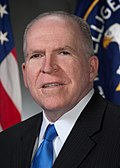Director of the Central Intelligence Agency
 From Wikipedia - Reading time: 8 min
From Wikipedia - Reading time: 8 min
| Director of the Central Intelligence Agency | |
|---|---|
 Seal of the Central Intelligence Agency | |
 Flag of the Central Intelligence Agency | |
since January 23, 2025 | |
| Central Intelligence Agency | |
| Abbreviation | D/CIA |
| Reports to | Director of National Intelligence (DNI) |
| Seat | George Bush Center for Intelligence, Langley, Fairfax County, Virginia |
| Appointer | President with Senate advice and consent |
| Term length | No fixed term |
| Constituting instrument | 50 U.S.C. § 3036 |
| Precursor | Director of Central Intelligence |
| Formation | December 17, 2004 |
| First holder | Porter J. Goss |
| Deputy | Deputy director |
| Salary | $225,700 Executive Schedule, Level II[1] |
| Website | www |
The director of the Central Intelligence Agency (D/CIA) is a statutory office (50 U.S.C. § 3036) that functions as the head of the Central Intelligence Agency, which in turn is a part of the United States Intelligence Community.
The director reports to the director of national intelligence (DNI) and is assisted by the deputy director of the Central Intelligence Agency (DD/CIA). The director is a civilian or a general or flag officer of the United States Armed Forces[2] nominated by the president of the United States, with the recommendation from the DNI,[3] and must be confirmed by a majority vote of the United States Senate.[4]
History
[edit]Before December 17, 2004 the director of central intelligence (DCI) headed both the Intelligence Community and the Central Intelligence Agency. In addition, DCI served as an advisor to the president of the United States on intelligence matters and was the statutory intelligence advisor to the National Security Council.
The post of DCI was established in 1946 by President Harry S. Truman;[5] it thus predates the establishment of the Central Intelligence Agency (created by the National Security Act of 1947). After the end of World War II, the Office of Strategic Services was dismantled. Its functions were split between the departments of state and war (now defense).[6] Truman soon recognized the inefficiency of this arrangement and created the Central Intelligence Group,[7] which could be considered a smaller precursor to the National Security Council.[8] The following year the National Security Act of 1947 created the Central Intelligence Agency and National Security Council, while formally defining the duties of the director of Central Intelligence. The duties of the DCI had been further defined over the years by tradition, congressional acts, and Executive Orders.
Beginning in February 2017, the D/CIA was elevated to Cabinet of the United States level status, as designated by the Trump administration. This ended with the beginning of the Biden administration.[9] In July 2023, the D/CIA was once again elevated to Cabinet of the United States level status by the Biden administration.[10]
Order of succession
[edit]The order of succession determines which official shall act and perform the functions and duties of the director in the event the director dies, resigns, or otherwise becomes unable to perform their duties. The official will serve as acting director.
If the official is already serving in an acting capacity, or otherwise not eligible under the Federal Vacancies Reform Act of 1998, the order skips to the next person in line. However, the president of the United States retains discretion to depart from the list in designating an acting director.[11]
| No. | Title |
|---|---|
1
|
Deputy director |
2
|
Chief operating officer |
3
|
Deputy director of CIA for operations |
4
|
Deputy director of CIA for analysis |
5
|
Deputy director of CIA for science and technology |
6
|
Deputy director of CIA for digital innovation |
7
|
Deputy director of CIA for support |
8
|
General counsel |
9
|
Deputy chief operating officer |
10
|
Senior CIA representative for the United Kingdom |
11
|
Senior CIA representative for the East Coast |
12
|
Senior CIA representative for the West Coast |
List of directors
[edit]Position succeeded the director of Central Intelligence.
| No. | Image | Name | Start | End | Duration | President | |
|---|---|---|---|---|---|---|---|
| 1 | 
|
Porter Goss[12] | December 17, 2004 | May 5, 2006 | 1 year, 24 days | George W. Bush (2001–2009) | |
| 2 | 
|
Michael Hayden[13] | May 30, 2006 | February 12, 2009 | 2 years, 260 days | ||
| 3 | 
|
Leon Panetta[14] | February 13, 2009 | June 30, 2011 | 2 years, 138 days | Barack Obama (2009–2017) | |
| – | 
|
Michael Morell Acting |
July 1, 2011 | September 6, 2011 | 68 days | ||
| 4 | 
|
David Petraeus[15] | September 6, 2011 | November 9, 2012 | 1 year, 66 days | ||
| – | 
|
Michael Morell Acting |
November 9, 2012 | March 8, 2013 | 130 days | ||
| 5 | 
|
John Brennan[16] | March 8, 2013 | January 20, 2017 | 3 years, 320 days | ||
| – | 
|
Meroe Park Acting |
January 20, 2017 | January 23, 2017 | 4 days | Donald Trump (2017–2021) | |
| 6 | 
|
Mike Pompeo[17] | January 23, 2017 | April 26, 2018 | 1 year, 94 days | ||
| 7 | 
|
Gina Haspel | April 26, 2018 | May 21, 2018 | 26 days | ||
| May 21, 2018 | January 20, 2021 | 2 years, 245 days | |||||
| – | 
|
David Cohen Acting |
January 20, 2021 | March 19, 2021 | 59 days | Joe Biden (2021–2025) | |
| 8 | 
|
Bill Burns | March 19, 2021 | January 20, 2025 | 3 years, 308 days | ||
| – | Tom Sylvester Acting |
January 20, 2025 | January 23, 2025 | 3 days | Donald Trump (2025–present) | ||
| 9 | 
|
John Ratcliffe | January 23, 2025 | Incumbent | 51 days | ||
See also
[edit]- Chief, IRS Criminal Investigation
- Director of the Federal Bureau of Investigation
- Director of the United States Marshals Service
- Director of the United States Secret Service
References
[edit]- ^ 5 U.S.C. § 5313
- ^ 10 U.S.C. § 528 Officers serving in certain intelligence positions: military status; exclusion from distribution and strength limitations; pay and allowances
- ^ 50 U.S.C. § 403-6 Appointment of officials responsible for intelligence-related activities
- ^ 50 U.S.C. § 3036 Director of the Central Intelligence Agency
- ^ "A Look Back … The National Security Act of 1947 — Central Intelligence Agency". www.cia.gov. Archived from the original on May 8, 2019. Retrieved February 6, 2017.
- ^ "Office of Strategic Services facts, information, pictures | Encyclopedia.com articles about Office of Strategic Services". www.encyclopedia.com. Retrieved February 6, 2017.
- ^ "The Organizational Arrangements for the Intelligence Community". www.gpo.gov. Retrieved February 6, 2017.
- ^ "Truman signs the National Security Act - Jul 26, 1947 - HISTORY.com". HISTORY.com. Retrieved February 6, 2017.
- ^ "The Cabinet". White House. Retrieved February 3, 2021.
- ^ Shear, Michael D. (July 21, 2023). "Biden Elevates CIA Director To Become a Member of the Cabinet". The New York Times. Retrieved July 21, 2023.
- ^ "Memorandum on Providing an Order of Succession Within the Central Intelligence Agency – The White House". trumpwhitehouse.archives.gov.
- ^ "Porter Johnston Goss". Central Intelligence Agency – Library. Archived from the original on September 23, 2020. Retrieved February 22, 2017.
- ^ "Michael Vincent Hayden". Central Intelligence Agency – Library. Archived from the original on August 4, 2019. Retrieved February 22, 2017.
- ^ "Leon Edward Panetta". Central Intelligence Agency – Library. Archived from the original on August 4, 2019. Retrieved February 22, 2017.
- ^ "David Howell Petraeus". Central Intelligence Agency – Library. Archived from the original on August 4, 2019. Retrieved February 22, 2017.
- ^ "John O. Brennan". Central Intelligence Agency – Leadership. Archived from the original on July 22, 2019. Retrieved February 25, 2017.
- ^ "Mike Pompeo". Central Intelligence Agency – Leadership. Archived from the original on April 9, 2019. Retrieved February 25, 2017.
 KSF
KSF
